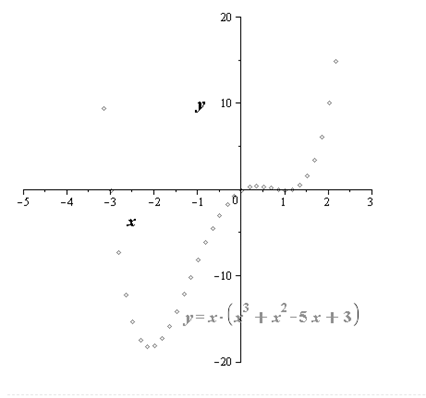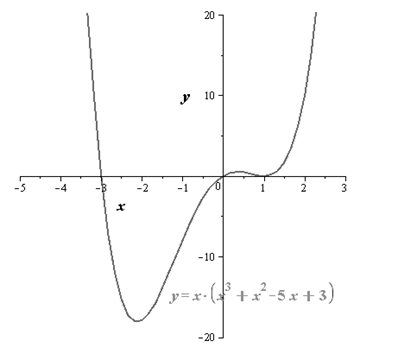
Concept explainers
(a)
Apply the coefficient test on function
(a)
Answer to Problem 20RE
The coefficient of highest power is positive graph will rise at LHS and also rise at RHS, the graph will rise at RHS and also rise at RHS.
Explanation of Solution
Given:
To apply the leading coefficient test on the
equation
The highest power is even and the coefficient of highest power is positive. So by leading coefficient test that when the highest power is even and the coefficient of highest power is positive graph will rise at LHS and also rise at RHS, the graph will rise at RHS and also rise at RHS.
(b)
Find the real zeros of the polynomial.
(b)
Answer to Problem 20RE
The zeros are 1,−3,0
Explanation of Solution
Given:
Find the zeros of this equation by equation it with 0, One of the zeros of this equation can be directly seen. It is x=0. For the other part of the equation
First equate it to zero and then find its roots.
So,
Zeros of such equations are found by first finding some of the roots by hit and trial and solving the rest. So,
Now, take out this factor from the equation and the rest of the equations will be Quadratic equation.
So the zeros are 1,−3,0
(c)
Plotting sufficient points.
(c)
Answer to Problem 20RE
Points are plotted below.
Explanation of Solution
Given:
Plot points for graph. For the points the graph will be like this,

(d)
Sketch
the continuous graph.
(d)
Answer to Problem 20RE
9532815067
Explanation of Solution
Given:
So the continuos graph is as follows,

Chapter 2 Solutions
EBK PRECALCULUS W/LIMITS
- Question Is the function f(x) shown in the graph below continuous at x = -5? f(z) 7 6 5 4 2 1 0 -10 -6 -5 -4 1 0 2 3 5 7 10 -1 -2 -3 -4 -5 Select the correct answer below: The function f(x) is continuous. The right limit exists. Therefore, the function is continuous. The left limit exists. Therefore, the function is continuous. The function f(x) is discontinuous. We cannot tell if the function is continuous or discontinuous.arrow_forwardThe graph of f(x) is given below. Select all of the true statements about the continuity of f(x) at x = -1. 654 -2- -7-6-5-4- 2-1 1 2 5 6 7 02. Select all that apply: ☐ f(x) is not continuous at x = -1 because f(-1) is not defined. ☐ f(x) is not continuous at x = −1 because lim f(x) does not exist. x-1 ☐ f(x) is not continuous at x = −1 because lim ƒ(x) ‡ ƒ(−1). ☐ f(x) is continuous at x = -1 J-←台arrow_forwardLet h(x, y, z) = — In (x) — z y7-4z - y4 + 3x²z — e²xy ln(z) + 10y²z. (a) Holding all other variables constant, take the partial derivative of h(x, y, z) with respect to x, 2 h(x, y, z). მ (b) Holding all other variables constant, take the partial derivative of h(x, y, z) with respect to y, 2 h(x, y, z).arrow_forward
- ints) A common representation of data uses matrices and vectors, so it is helpful to familiarize ourselves with linear algebra notation, as well as some simple operations. Define a vector ♬ to be a column vector. Then, the following properties hold: • cu with c some constant, is equal to a new vector where every element in cv is equal to the corresponding element in & multiplied by c. For example, 2 2 = ● √₁ + √2 is equal to a new vector with elements equal to the elementwise addition of ₁ and 2. For example, 問 2+4-6 = The above properties form our definition for a linear combination of vectors. √3 is a linear combination of √₁ and √2 if √3 = a√₁ + b√2, where a and b are some constants. Oftentimes, we stack column vectors to form a matrix. Define the column rank of a matrix A to be equal to the maximal number of linearly independent columns in A. A set of columns is linearly independent if no column can be written as a linear combination of any other column(s) within the set. If all…arrow_forwardThe graph of f(x) is given below. Select each true statement about the continuity of f(x) at x = 3. Select all that apply: 7 -6- 5 4 3 2 1- -7-6-5-4-3-2-1 1 2 3 4 5 6 7 +1 -2· 3. -4 -6- f(x) is not continuous at a = 3 because it is not defined at x = 3. ☐ f(x) is not continuous at a = - 3 because lim f(x) does not exist. 2-3 f(x) is not continuous at x = 3 because lim f(x) ‡ ƒ(3). →3 O f(x) is continuous at a = 3.arrow_forwardIs the function f(x) continuous at x = 1? (z) 6 5 4 3. 2 1 0 -10 -9 -7 -5 -2 -1 0 1 2 3 4 5 6 7 8 9 10 -1 -2 -3 -4 -5 -6 -7 Select the correct answer below: ○ The function f(x) is continuous at x = 1. ○ The right limit does not equal the left limit. Therefore, the function is not continuous. ○ The function f(x) is discontinuous at x = 1. ○ We cannot tell if the function is continuous or discontinuous.arrow_forward
- Is the function f(x) shown in the graph below continuous at x = −5? f(x) 7 6 5 4 2 1 0 -10 -9 -8 -7 -6 -5 -4 -3 -2 -1 0 1 2 3 4 5 6 7 8 9 10 -1 -2 -3 -4 -5 -6 -7 Select the correct answer below: The function f(x) is continuous. ○ The right limit exists. Therefore, the function is continuous. The left limit exists. Therefore, the function is continuous. The function f(x) is discontinuous. ○ We cannot tell if the function is continuous or discontinuous.arrow_forward4. Evaluate the following integrals. Show your work. a) -x b) f₁²x²/2 + x² dx c) fe³xdx d) [2 cos(5x) dx e) √ 35x6 3+5x7 dx 3 g) reve √ dt h) fx (x-5) 10 dx dt 1+12arrow_forwardMath 2 question. thxarrow_forward
- Please help on this Math 1arrow_forward2. (5 points) Let f(x) = = - - - x² − 3x+7. Find the local minimum and maximum point(s) of f(x), and write them in the form (a, b), specifying whether each point is a minimum or maximum. Coordinates should be kept in fractions. Additionally, provide in your answer if f(x) has an absolute minimum or maximum over its entire domain with their corresponding values. Otherwise, state that there is no absolute maximum or minimum. As a reminder, ∞ and -∞ are not considered absolute maxima and minima respectively.arrow_forwardLet h(x, y, z) = — In (x) — z y7-4z - y4 + 3x²z — e²xy ln(z) + 10y²z. (a) Holding all other variables constant, take the partial derivative of h(x, y, z) with respect to x, 2 h(x, y, z). მ (b) Holding all other variables constant, take the partial derivative of h(x, y, z) with respect to y, 2 h(x, y, z).arrow_forward
 Calculus: Early TranscendentalsCalculusISBN:9781285741550Author:James StewartPublisher:Cengage Learning
Calculus: Early TranscendentalsCalculusISBN:9781285741550Author:James StewartPublisher:Cengage Learning Thomas' Calculus (14th Edition)CalculusISBN:9780134438986Author:Joel R. Hass, Christopher E. Heil, Maurice D. WeirPublisher:PEARSON
Thomas' Calculus (14th Edition)CalculusISBN:9780134438986Author:Joel R. Hass, Christopher E. Heil, Maurice D. WeirPublisher:PEARSON Calculus: Early Transcendentals (3rd Edition)CalculusISBN:9780134763644Author:William L. Briggs, Lyle Cochran, Bernard Gillett, Eric SchulzPublisher:PEARSON
Calculus: Early Transcendentals (3rd Edition)CalculusISBN:9780134763644Author:William L. Briggs, Lyle Cochran, Bernard Gillett, Eric SchulzPublisher:PEARSON Calculus: Early TranscendentalsCalculusISBN:9781319050740Author:Jon Rogawski, Colin Adams, Robert FranzosaPublisher:W. H. Freeman
Calculus: Early TranscendentalsCalculusISBN:9781319050740Author:Jon Rogawski, Colin Adams, Robert FranzosaPublisher:W. H. Freeman
 Calculus: Early Transcendental FunctionsCalculusISBN:9781337552516Author:Ron Larson, Bruce H. EdwardsPublisher:Cengage Learning
Calculus: Early Transcendental FunctionsCalculusISBN:9781337552516Author:Ron Larson, Bruce H. EdwardsPublisher:Cengage Learning





